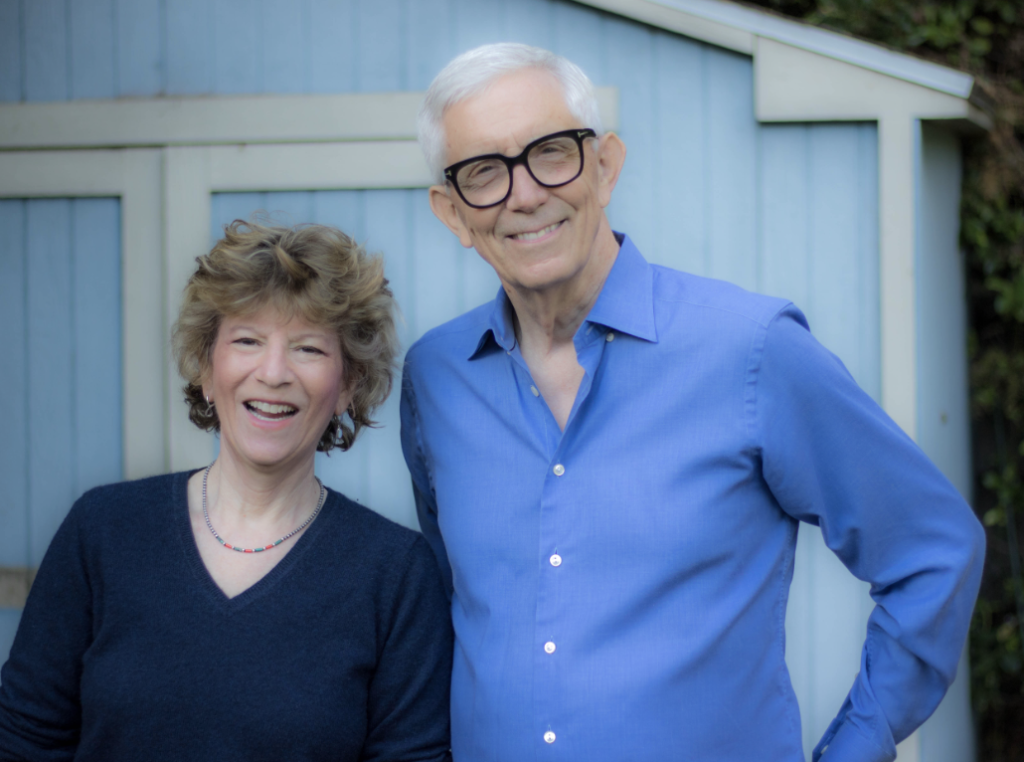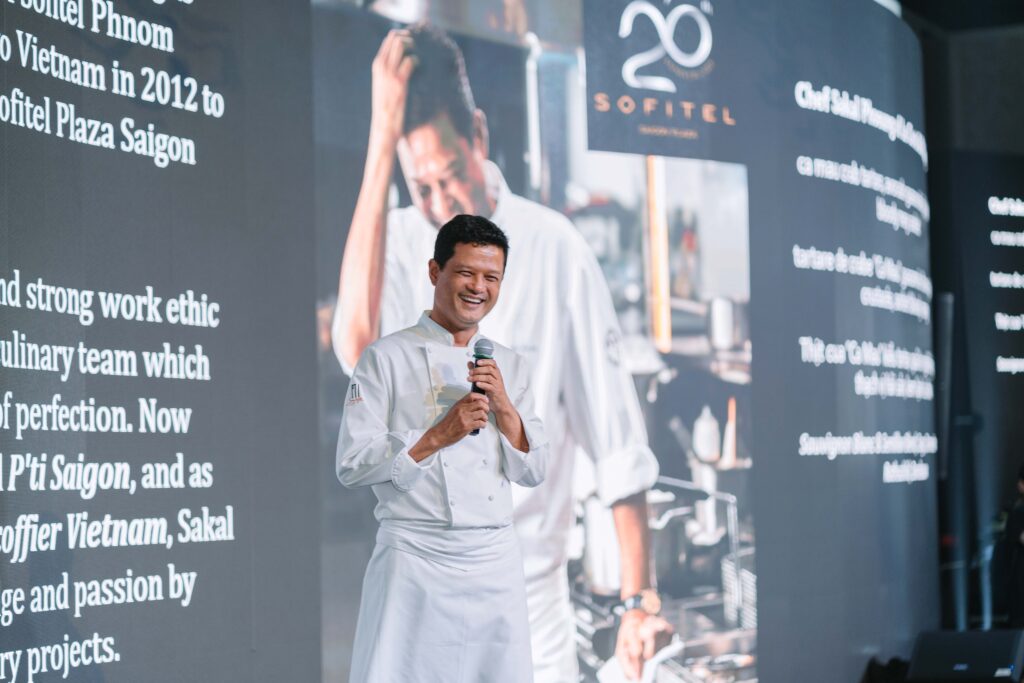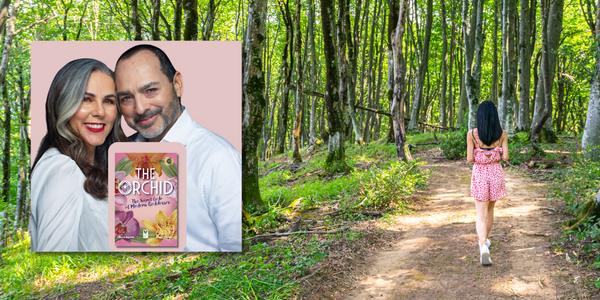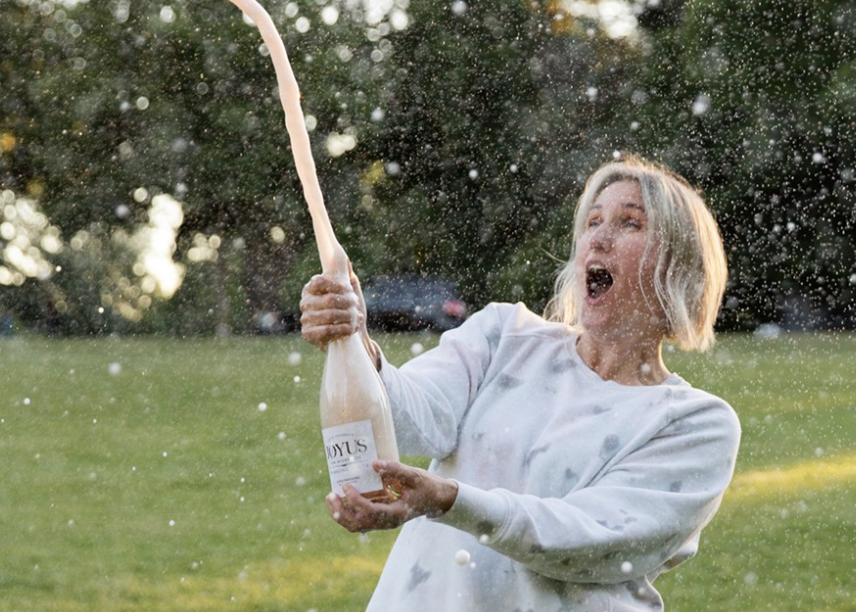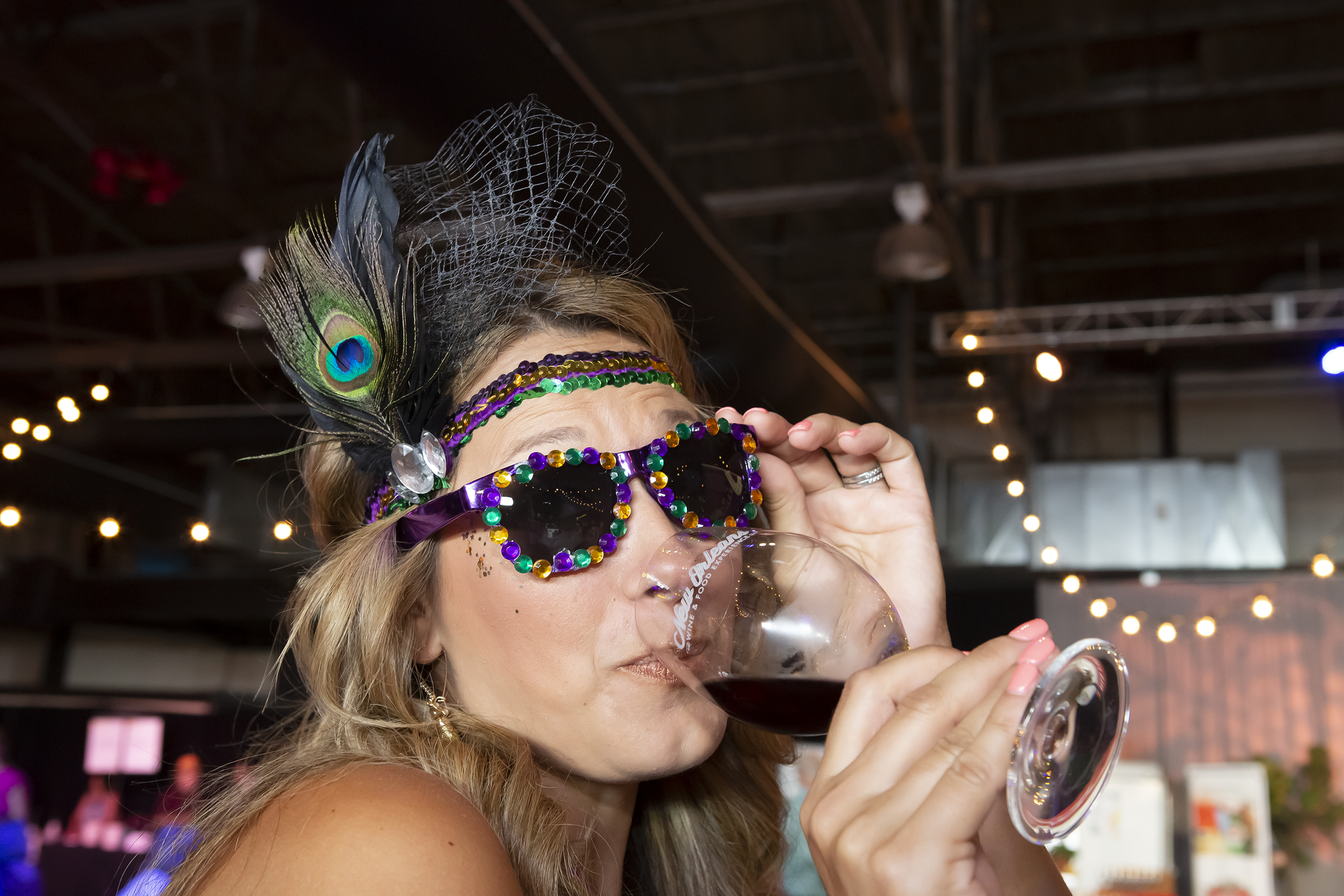DC Foodies top the list — curious about Plant-Based Honey taste, Mellody’s Darko Mandich reveals the surprise.
DC Foodies are a different type. Hungry and always eager to try something new. Known for its adventurous foodies and curious eaters. Plenty of people are already in line to try plant-based honey, but what does it actually taste like?
People might worry there’s a “laboratory” flavor? Has it lost its texture? Vibrancy? Is there a “diet” feel to it?
Exclusive Interview with Mellody Food’s Darko Mandich.
Darko Mandich is a food entrepreneur in San Francisco. After spending almost a decade in the European honey industry as a business executive, Darko committed to reimagining the honey industry to become sustainable. Darko immigrated from Europe to California to launch Mellody, the world’s first plant-based honey brand. Darko is an advocate of saving the bees and wild pollinators.

Mellody Food’s Darko Mandich
Recently, I had a chance to talk with Darko for nearly an hour.
Let’s talk about the honey. What’s the taste profile?
There are three aspects of products that people care about. Number one by far is taste. Number two is price, and number three is nutrition.
In terms of the taste, what we’re really after is the best tasting honeys that are made by bees.
The taste has to match rare honeys that you would find in parts of Europe; France, Italy. Very high quality Acacia honey, specifically.
If we talk about New Zealand, Australia, that’s Manuka honey; and we’re matching that.
So no compromise there.
Moving to the price, I grew up in poverty and I really want to make sure that everybody has access to this product at some point. But it’ll take us some time. So right now it’s premium quality, but it’s also premium price.
In terms of nutrition, we wanna do better than honey coming from bees. How? First and foremost, honey made by the bees contains a certain bacteria that’s called Clostridium. With our product, without the bees [there’s no Clostridium] bacteria.
I’m really proud to say that our product is allergen free; and that for people with allergies to honey and pollen, this is gonna be neutral.
Finally in terms of super ingredients or superfoods, our honey has more than what’s usually found in some of the honey types made by the bees.
The sugar profile is the same, the calorie content is the same, but the twist is there’s a little bit more of certain powerful active compounds that come from the plants.
That’s absolutely incredible. It’s enhanced honey. Is there a better word?
I like to call it a plant-based honey. And that category of plant-based honey is already elevated to the level of being enhanced compared to bee-made honey.
I’m really happy that Melody is starting this category. We are the world’s first plant-based honey.
There’s exactly one same sentence that we get to hear across 5,000 people that were involved in tasting this before it hit the market.
That sentence is: It’s honey.
People taste it, they’re amazed with it, and they say, “Oh my God, it’s honey.”
There are certain plant-based products that have their heart in best place in terms of mission and impact, but are just not delivering on [flavor] expectations. We just want to make sure that people across different categories of nutrition say that this is honey and that they love it.
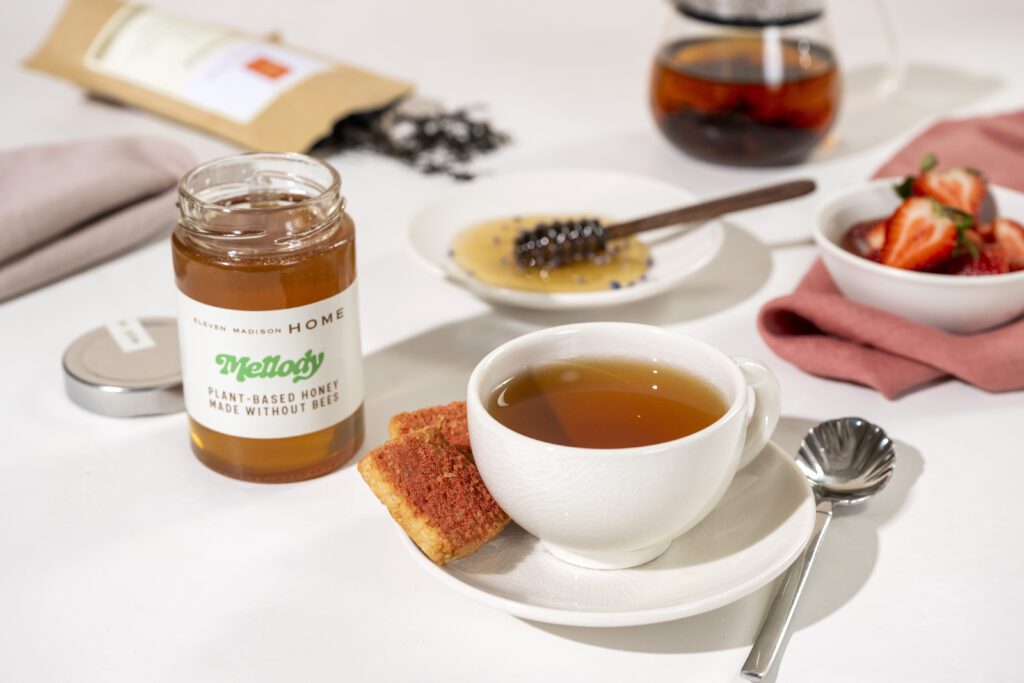
Eleven Madison Home’s The Specialty Tea and Honey Box featuring Mellody Honey
Is the honey currently available at Eleven Madison Home?
Yeah, the honey is currently available. The Specialty Tea and Honey Box launched for the Mother’s Day collection and Earth Month.
It’s a specially curated box of artisanal teas coming from different parts of the world with honey and also amazing, shortbread cookies. All plant-based, also made with our honey. That’s available right now
Sometime very soon a standalone jar [of honey] will also be available to Eleven Madison Home.
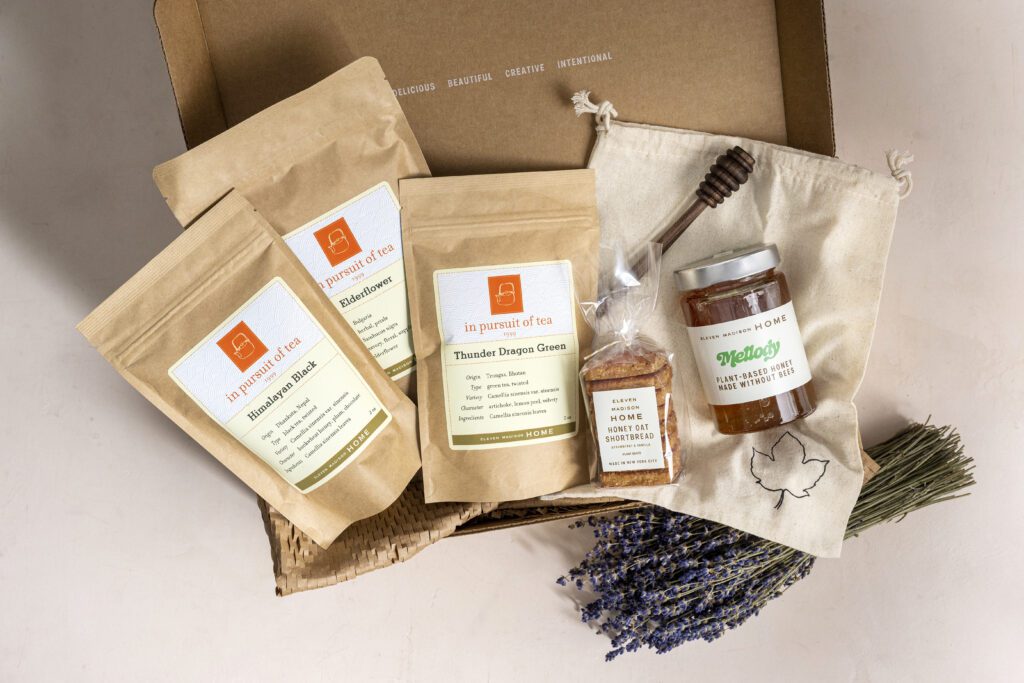
Eleven Madison Home’s The Specialty Tea and Honey Box featuring Mellody Honey
Tell us again what’s available, how to find it; and how to follow you and support you.
Yeah, follow us on Instagram and TikTok at MellodyFoods
In terms of purchasing, head to ElevenMadisonHome.com and you can purchase it there.
Saving the bees is learning more about them. Learning more about pollinators and you can do that on our social media.
And finally, if you’re equally passionate about bees and plants as we are, ask your favorite restaurant to reach out to us to offer Mellody in your favorite restaurant. It can be a vegan restaurant on non-vegan.
We are gonna work with all the restaurants that reach out to us where people ask to see our product offered, either on the menu, either within a meal, or just if you order a cup of tea and you want a side of Mellody.
YOU MIGHT ALSO LIKE
Bubbly East Coast Prosecco Tasting! Discover with Wine Expert Alan Tardi Wed June 26th at New York Wine Studio
DC Heads to NYC for Prosecco! Taste and Discover with Wine Expert Alan Tardi Wed June 26th at New York Wine Studio
Prosecco has gone from a little known mountain fizz to a vinous superhero, overtaking Champagne (and every other sparkling wine out there) and enjoyed by wine drinkers throughout the world, as the base of a cocktail or an everyday quaff.
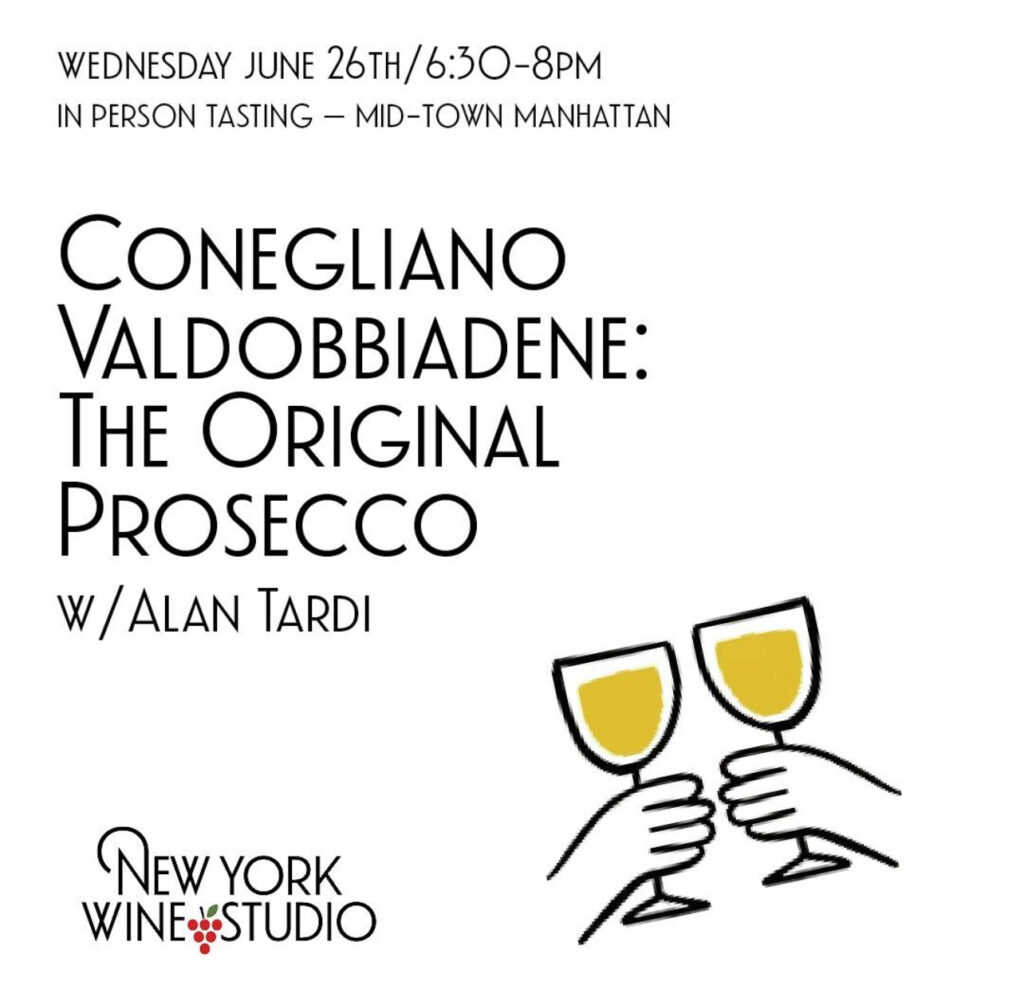
But despite its huge popularity, most people don’t know much about it.
And there is much more to Prosecco than many people are aware.
”My objective is to
clarify the critical differences
between the original ancient Conegliano Valdobbiadene Prosecco and
the DOC Prosecco that was enacted in 2010.”
Alan Tardi
New York Wine Studio
Prosecco is produced only in Italy, in the Northern regions of Veneto and Friuli, and there are three official Prosecco appellations.

Prosecco DOC
One of them, Prosecco DOC, was created in 2010. It occupies a huge, mostly flat area encompassing almost two entire regions and accounts for most of the 700+ million bottles of Prosecco produced each year.
Conegliano Valdobbiadene Prosecco DOCG
Conegliano Valdobbiadene Prosecco DOCG is a tiny area in the foothills of the Dolomites consisting of 15 small municipalities in the province of Treviso. This is the ancient winegrowing area where Prosecco was born and made a miraculous comeback in the aftermath of World War II.

New York Wine Studio’s Alan Tardi
Besides its pedigree, there are numerous factors of the Conegliano Valdobbiadene enclave that distinguish it from any other winegrowing area in the world: complex and diverse topography, variety of soils, native grape varieties, distinct sub-areas, ancient history, and varied typology—bubbly, fizzy, and still; secondary fermentation in tank or in bottle, leaving sediment in the bottle (known as Ancestral Method) or removing it (Traditional Method).

In this class—which takes place right in the middle of National Prosecco DOC week—we will discuss the origin and evolution of Prosecco in the Conegliano Valdobbiadene area. We will also examine the two additional Prosecco appellations created in 2010.
But most of the time will be devoted to exploring and tasting Conegliano Valdobbiadene Prosecco through a lineup of 8 exceptional terroir-driven wines, in a variety of styles, that demonstrate the unique characteristics, complexity, and diversity of the original Prosecco.
Participants will also learn how to say “CONEGLIANO VALDOBBIADENE” like an Italian!

Alan Tardi has arranged a fantastic lineup of unusual and exceptional wines (half of them are coming directly from Italy) which demonstrate the various factors that characterize the complexity and uniqueness of Conegliano Valdobbiadene: Different production methods (“Tranquillo” i.e. still, Martinotti, Classico/Traditional, Ancestral); frizzante, spumante; single vineyards, Rive, native grape varieties; diverse, soils, terroirs and topographies.
List of Wines
- Prosecco Tranquillo DOCG “Il Canto Antico” — BORTOLOMIOL*
- Colli Trevigiani IGT Verdiso Frizzante Sui Lieviti — GREGOLETTO
- Progetto 5 Varietà Conegliano Valdobbiadene DOCG Brut — MARCHIORI*
- Conegliano Prosecco Superiore DOCG Rive di Ogliano Extra-Brut — BIANCAVIGNA
- Superiore di Cartizze Brut DOCG — RUGGERI*
- Superiore di Cartizze DOCG “Private” Rifermentato in Bottiglia 2014 — BISOL
- Conegliano Valdobbiadene Prosecco Superiore DOCG Rive di Carpesica “S.C. 1931” Metodo Classico — BELLENDA*
- Valdobbiadene Prosecco Superiore DOCG Asciutto, Rive di Colbertarldo, Vigneto Giardino — ADAMI
- Torchiato di Fregona Colli di Conegliano DOCG “Ciàcoe” 2016 — CA’ DI RAJO*
*Shipped directly from the winery in Italy
Find more information and buy tickets at New York Wine Studio or at the link below.
https://www.newyorkwinestudio.com/original-prosecco
Bob Dylan’s Bourbon Feud: Heaven’s Door Kentucky vs Tennessee
Bob Dylan’s Bourbon Feud: Heaven’s Door Kentucky vs Tennessee
Heaven’s Door Spirits, Bob Dylan’s highly awarded collection of super-premium American whiskeys, is turning up the heat on the age-old debate of which state, Tennessee or Kentucky, makes the best bourbon.
For as long as corn’s been cracked and stills have bubbled, Kentucky and Tennessee have been turning pristine limestone water and grains into a coveted amber elixir.
Heaven’s Door’s Great State Bourbon Debate rekindles the friendly feud
Heaven’s Door’s Great State Bourbon Debate rekindles the friendly feud between these two bourbon powerhouses, inviting whiskey lovers everywhere to put their palates to the test and voice their opinion.
Heaven’s Door sets itself apart as the first brand to offer both a Kentucky and Tennessee bourbon, giving fans a unique chance to compare.
The brand’s Kentucky Straight Bourbon, Ascension, and Tennessee Straight Bourbon, Revival, are made from high rye mash bills with grains largely sourced local to the distillery, and barreled at the same proof, yet yield vastly different taste profiles. Heaven’s Door invites you to level set, savor and decide which bourbon pleases your palate and wins your heart.
A Tale of Two Bourbons
Many folks mistakenly believe that bourbon can only be made in Kentucky, but the truth is, bourbon can be crafted anywhere in the U.S.
What makes an American whiskey a true bourbon is a special set of rules: it has to be made with at least 51% corn, distilled at a certain proof, and aged in new oak barrels.
Kentucky and Tennessee both have storied histories of producing excellent bourbon, with differences in water and climate producing distinct flavors.
Kentucky’s limestone water and Tennessee’s pure spring water are both famous for helping yeast thrive during fermentation.v
Differences in flavor profile come from the type and provenance of the grains used, the type of yeast used, water quality, the proof at distillation and the particular wood used to make oak barrel.
Even the location of the barrel warehouse, the circulation of air between the barrels being stored and where the barrels are within the warehouse (high up or near the bottom) all conspire to give impart flavor differences.
Heaven’s Door Kentucky Straight Bourbon, Ascension
Heaven’s Door Kentucky Straight Bourbon, Ascension, is a unique blend of two premium Kentucky straight bourbons aged for over five years and non-chill filtered, boasts warm and slightly sweeter notes of vanilla and baking spices. The limestone-filtered water of Kentucky, renowned for its purity, plays a key role in developing these rich flavors.
Heaven’s Door Tennessee Straight Bourbon, Revival
Heaven’s Door Tennessee Straight Bourbon, Revival, also aged for over five years and non-chill filtered, offers a drier profile with complex and sharp flavors. Unlike many Tennessee bourbons, Revival skips the “Lincoln County Process” – a charcoal filtering step – allowing the natural flavors of the local non-GMO grains to shine through, resulting in a lingering finish with hints of caramel, cinnamon, and nutmeg.
“We wanted to fan the flames of this old debate
between Kentucky and Tennessee bourbon
and showcase
our outstanding expressions of both styles.
We’re excited to hear what consumers think and how they experience these two classic bourbons.”
Alex Moore
Master Blender and COO
Heaven’s Door Spirit
Heaven’s Door marries art and craft in every bottle, drawing inspiration from Bob Dylan’s restless spirit to continually innovate. By sourcing non-GMO grains and honoring each state’s natural elements, the distinct character of each bourbon is evident in every sip.
Yo DC! Following your Heart and Need Media Attention? Reach to Publicity For Good, CEO Heather Holmes explains
Yo DC! Following your Heart and Need Media Attention? Reach to Publicity For Good, CEO Heather Holmes explains
Publicity for Good is a millennial run communications firm that provides high-level disruptive, publicity and social media services for wide array of purpose driven clients in the food, beverage and beauty industry.
In 2016 by Heather Holmes former miss Ohio international celebrated publicist and Forbes 30 under 30 nominee publicity for good has built a reputation as the countries number one PR agency for CPG brands that have social causes built into their DNA.
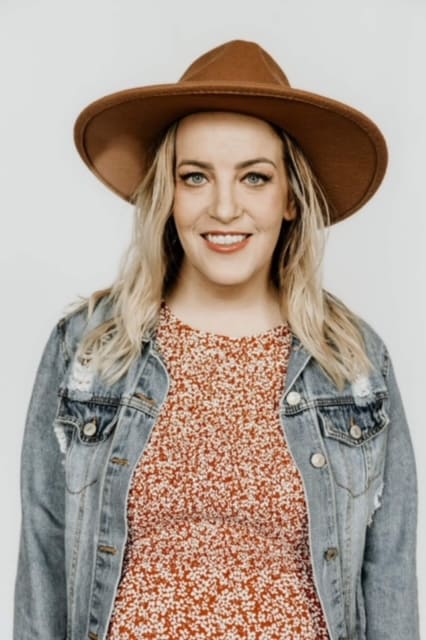
Publicity For Food CEO Heather Holmes
Today’s conversation with Heather Homes from PublicityForGood.com has been edited for length and clarity. For the full, un-edited conversation, visit our YouTube channel here.
Joe Winger:
Heather Holmes from PublicityForGood.com. I’m a big fan because you’ve helped us facilitate a lot of previous conversations about food and drink and nutrition and all the things we like talking about.
What’s the most important thing that you want to share with the audience today?
Heather Holmes:
I really want to take away the unknown or worry about getting in the media. I want to make it more accessible to amazing brands and people.
So I definitely want to share tactical advice that if someone is reading this, they have a good story in business, they have the confidence that their story is good enough and they could absolutely make an impact and grow their business by getting in the media.
Joe Winger:
Starting with the basics, let’s pretend I have a company, I think I want public attention. I want to reach out to someone like you.
So what should I be thinking about? What do I present to you as a step one?
Heather Holmes:
Step one is really the intentionality of why you want to get in the media. What’s your goal? Are you wanting to reach more people? Are you wanting to get your story out there?
Are you wanting more sales and more people to buy your product?
You really need to know. Where you’re going first, and if you don’t know where you’re going, or you don’t have a vision, then it’s really hard to help you.
But if you have clarity there, then we can really pull back and help you identify your story, how you’re different, your why, and why your product and or company, would be really great to be in the media.

The PublicityForGood Team
Joe Winger:
Now, looking at the grand scheme of the campaign, what kind of a campaign should we be looking for: expectations, results?
Heather Holmes:
After we know our outcome that we’re wanting to get more sales, more backlinks, or name in the media, then what I like to do first is work with every entrepreneur, and even if you have a product, to really reflect in “why your story matters”
Why does your product matter?
If you’ve never been in the media before, I take people for an exercise where I have them draw on a piece of paper, them as a baby, to where they are now.
I have them write the key pivotal moments that have happened in their life that have made them start that company, because those little components are absolutely a part of your story.
I’ve been in the media 700 plus times: Inside Edition, Fox News, The New York Coast, incredible media, but it hasn’t always been about being a publicist, right?
Yes. I’m the founder of Publicity For Good, but a lot of that has been my story or building a seven figure company from an airstream.
Now I have almost two under two with a third on the way.
So you need to have your key pivotal moments because those are things you can talk about in the media.
Then we need to look at what’s going on in the news and how we bridge the gap between your product. Relevancy.

Joe Winger:
People may not know you are a former Miss Ohio International. Can you tell us a lesson you learned from being a former Miss Ohio International that you’re using in today’s work?
Heather Holmes:
It’s really all about your platform and reaching new audiences.
When I was building my company I decided I wanted to get into pageants. I wanted to meet a community of like minded people that wanted to make a difference in the world.
It was a way for me to have a platform because at the time I was talking about why you absolutely can build a profitable business. But also make a difference in your community and make a difference amongst your team. And really just build an incredible legacy.
So that was why I did the pageants.
I did a bunch of publicity and again, it made me relevant and timely because that was what got me in the media because I was Miss Ohio and I was only Miss Ohio International for a period of time.
So it gave me that relevancy. So you have to be relevant.
You have to bridge the gap between what’s happening in the news, or we often use Awareness Days, National Nutrition Month, National Social Media Day, and you have to position your product or yourself as the solution.
[For example], we were talking about an incredible juice brand, but most pitches I see are very promotional, right? It needs to be how you or your product simplifies people’s lives. How are you adding value? Or you don’t have a product you need to inspire people.

Joe Winger:
You’re growing a 7- figure business. What’s it like growing a huge business while you’re taking care of your kids and for a while you were living out of your Airstream
Heather Holmes:
We lived out of a 23 foot airstream for 3 1/2 years. I went from dating to engaged, to married to [my first child] Rose, who’s almost two, who lived in our airstream with us.
The year the pandemic [hit] was our first million dollar year.
I think a lot of the reason why it was that year is because when March hit, everyone was so scared that we lost about 40% of our business, number one.
Number two, we had to hustle and grit to make it. There was no choice of failing. All the distractions were gone.
When you’re in an Airstream, all you have is your laptop, but we had no external distractions, and then everything else was closed.
So the only focus we could do was our business and we had to scale out of necessity because we didn’t want to lose what we had put so much time in.
Fast forward, we now have 22 acres where we live and we have two under two, we have one on the way, we’re a full time team of 40, and it’s not easy.
I say transparently, it’s a hot mess. There are so many miracles that happen every day, but life is one, right? I can’t turn off my founder hat and publicist hat and then “Oh, I’m a mom”. It’s all one.
So yes, I might have Rose [my daughter] on a call with me from time to time, but I’ve learned that the more you step in and embrace your life, who you are and the realness, sometimes people opt out and that’s okay.
And this is my legacy.
I like these missions that we’re doing good work to us is way more than a business. We want to grow your brand and mission and we take it so seriously.
So it’s not perfect. It’s not perfectly scheduled. I’m a full time mom, all the time on the weekends when the kids are sleeping, we’re working.
We know where we want to go, and these clients and ambitions that we’re aligned with and supporting are helping people with their health.
Joe Winger:
What an incredible story to share.
Heather Holmes: I have so much to share. Like I was adopted when I was a week old to having two under two and another one on the way and building a business and building a homestead.
It’s so crazy. Austin, who’s my husband, the first week we were dating, we’re all about intentionality. I have the journal and we mapped everything out.
This year, we were going to get engaged then married. Austin and I,l we will have been together almost five years.
We’ve had a kid every year. Rose will be two in June.
We want to build a business. We want to impact our clients, brands, and scale their business. We want our team to get better and flourish in their personal lives too.
This is our mission and I’ve seen so many miracles happen from getting in the media on a personal level.
I was talking to [a business owner client] and her business grew by 40% from getting in the media.
One of my favorite cookie brands, a mom had an incredible heart story. She went on our local news and she brought in $12,000 worth of sales, just the local people wanting to support her.
On the flip side, when people Google my name, it’s like my social currency, there’s all these articles. So I have so much peace in that. Our kids will see the good work we’re doing.
Joe Winger:
You’re talking to an audience of foodies. What is your favorite meal?
Heather Holmes:
We just had Indian food last night that my husband made and it was so good.
We used to live in San Diego and I think San Diego has the best food. It’s all fresh. We’ve traveled a lot. We’ve been to Bali, their food is pretty incredible too. Where we live [now] we’re right outside of Asheville and Charlotte. So they have some good restaurants, but like I’m not in the phase right now where I’m the foodie like I used to be.
[At our house] we have chickens and we have fresh eggs. So I’m obsessed with fresh eggs every morning. You’re living a good life when you can go get your eggs and have them at home with some goat cheese.
And honestly, I love Livermuth. Crazy. So I’d say some Livermuth fried in a cast iron with some eggs and goat cheese. It’s the simple things that I really do love.
Joe Winger:
Heather Holmes with Publicity for Good. As we wrap up, whether it’s a potential client, a potential vendor, someone wanting your help with publicity, what are the best ways to find, follow you, websites, social media, etc?
Heather Holmes:
You can go to PublicityForGood.com You can find me on social media as well.
https://www.linkedin.com/in/heatherdesantis
https://www.instagram.com/heatherdesantis
https://www.instagram.com/publicity.for.good
https://www.facebook.com/heatherdesantis
About the Author
Joe Wehinger (nicknamed Joe Winger) has written for over 20 years about the business of lifestyle and entertainment. Joe is an entertainment producer, media entrepreneur, public speaker, and C-level consultant who owns businesses in entertainment, lifestyle, tourism and publishing. He is an award-winning filmmaker, published author, member of the Directors Guild of America, International Food Travel Wine Authors Association, WSET Level 2 Wine student, WSET Level 2 Cocktail student, member of the LA Wine Writers. Email to: Joe@FlavRReport.comYou Might also like
-
Bob Dylan’s Bourbon Feud: Heaven’s Door Kentucky vs Tennessee
Bob Dylan’s Bourbon Feud: Heaven’s Door Kentucky vs Tennessee
Heaven’s Door Spirits, Bob Dylan’s highly awarded collection of super-premium American whiskeys, is turning up the heat on the age-old debate of which state, Tennessee or Kentucky, makes the best bourbon.
For as long as corn’s been cracked and stills have bubbled, Kentucky and Tennessee have been turning pristine limestone water and grains into a coveted amber elixir.
Heaven’s Door’s Great State Bourbon Debate rekindles the friendly feud
Heaven’s Door’s Great State Bourbon Debate rekindles the friendly feud between these two bourbon powerhouses, inviting whiskey lovers everywhere to put their palates to the test and voice their opinion.
Heaven’s Door sets itself apart as the first brand to offer both a Kentucky and Tennessee bourbon, giving fans a unique chance to compare.
The brand’s Kentucky Straight Bourbon, Ascension, and Tennessee Straight Bourbon, Revival, are made from high rye mash bills with grains largely sourced local to the distillery, and barreled at the same proof, yet yield vastly different taste profiles. Heaven’s Door invites you to level set, savor and decide which bourbon pleases your palate and wins your heart.
A Tale of Two Bourbons
Many folks mistakenly believe that bourbon can only be made in Kentucky, but the truth is, bourbon can be crafted anywhere in the U.S.
What makes an American whiskey a true bourbon is a special set of rules: it has to be made with at least 51% corn, distilled at a certain proof, and aged in new oak barrels.
Kentucky and Tennessee both have storied histories of producing excellent bourbon, with differences in water and climate producing distinct flavors.
Kentucky’s limestone water and Tennessee’s pure spring water are both famous for helping yeast thrive during fermentation.v
Differences in flavor profile come from the type and provenance of the grains used, the type of yeast used, water quality, the proof at distillation and the particular wood used to make oak barrel.
Even the location of the barrel warehouse, the circulation of air between the barrels being stored and where the barrels are within the warehouse (high up or near the bottom) all conspire to give impart flavor differences.
Heaven’s Door Kentucky Straight Bourbon, Ascension
Heaven’s Door Kentucky Straight Bourbon, Ascension, is a unique blend of two premium Kentucky straight bourbons aged for over five years and non-chill filtered, boasts warm and slightly sweeter notes of vanilla and baking spices. The limestone-filtered water of Kentucky, renowned for its purity, plays a key role in developing these rich flavors.
Heaven’s Door Tennessee Straight Bourbon, Revival
Heaven’s Door Tennessee Straight Bourbon, Revival, also aged for over five years and non-chill filtered, offers a drier profile with complex and sharp flavors. Unlike many Tennessee bourbons, Revival skips the “Lincoln County Process” – a charcoal filtering step – allowing the natural flavors of the local non-GMO grains to shine through, resulting in a lingering finish with hints of caramel, cinnamon, and nutmeg.
“We wanted to fan the flames of this old debate
between Kentucky and Tennessee bourbon
and showcase
our outstanding expressions of both styles.
We’re excited to hear what consumers think and how they experience these two classic bourbons.”
Alex Moore
Master Blender and COO
Heaven’s Door Spirit
Heaven’s Door marries art and craft in every bottle, drawing inspiration from Bob Dylan’s restless spirit to continually innovate. By sourcing non-GMO grains and honoring each state’s natural elements, the distinct character of each bourbon is evident in every sip.
Post Views: 148 -
Tasty Times for DC! New Orleans Wine & Food Experience 2023 runs June 7 – 11
The New Orleans Wine & Food Experience 2023 runs June 7 – 11 Uncorks Grand Plan and New Venue
The New Orleans Wine & Food Experience announces that a limited number of exclusive ticket packages and all individual event tickets are now on sale for the five-day event set for June 7 – 11.
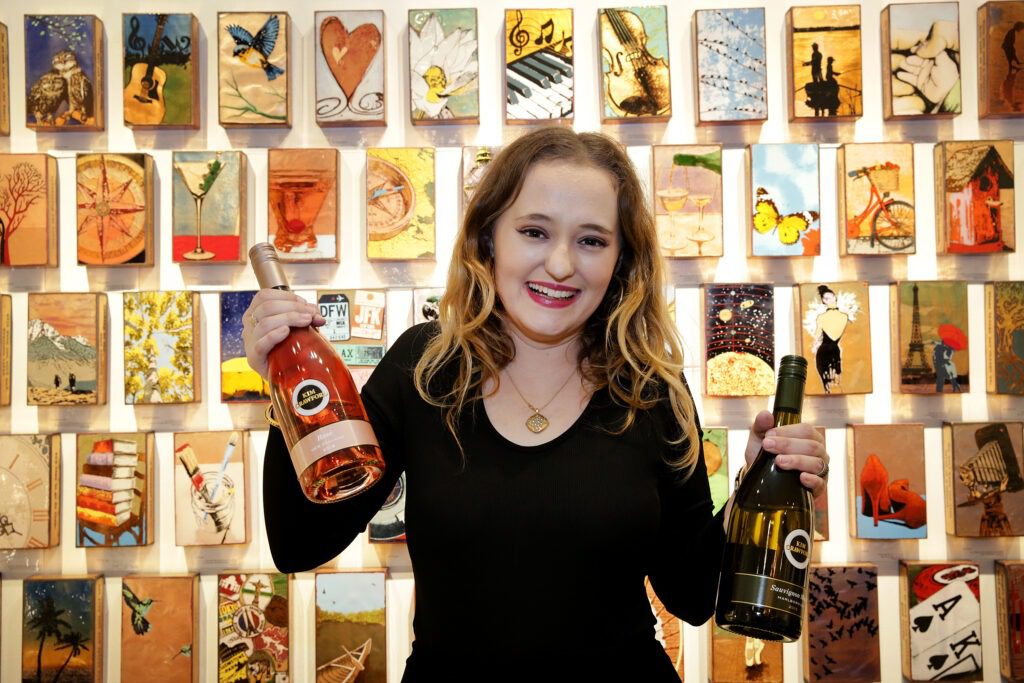
“This year, we have enhanced our three big events—
Vinola, Tournament of Rosés, and our Grand Tasting…
making them bigger and better than ever before and moving them to new venues,” said Aimee Brown, NOWFE Executive Director.
“In response to high demand, we have added special ticket packages for those attendees looking to spend a few days with us.
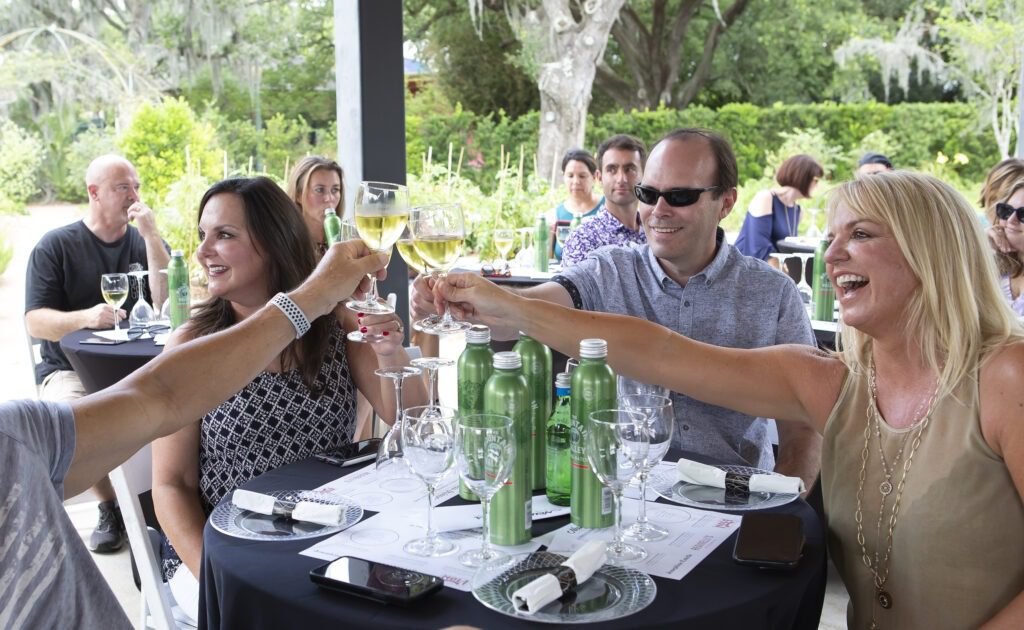
And, for the many locals that love to attend our events, we offer the individual ticket option to fit personal schedules and lifestyles.”
Vinola at the The New Orleans Wine & Food Experience
Vinola, the highest-level tasting event NOWFE offers, kicks off at the historic Orpheum Theater on Thursday, June 8, at 6 pm.Foodies and oenophiles of all experience levels will sample rare and highly valued wines expertly paired with delectable foods crafted by local chefs. Winemakers will present elite wines from around the world, and award-winning chefs will serve and talk about their food and what inspires them in its creation. Guests will have the chance to have one-on-one conversations with winemakers and chefs. Tickets are $215 each. VIP tickets are $280 and include 30-minute early entry and VIP lounge access.
Tournament of Rosés
Back for the fifth year, the Tournament of Rosés is moving to The Fillmore on Friday, June 9th, at 7:00 PM. Tickets to this special event are $129 per person.

The Tournament of Rosés offers guests a unique opportunity to taste premier rosés, both still and sparkling, from France, Spain, Italy, the United States, and the Southern Hemisphere, and then cast a vote for a favorite.
Best of Show, Gold, Silver, Bronze and the People’s Choice Award will be announced.
New this year, a specialty sparkling sector featuring bubbles beyond the Rosé realm and a spirited cocktail garden. Tasty bites will accompany each wine served. Guests are encouraged to come “dressed to impress” with a touch of pink. VIPs gain 30 minutes of early access to this event.
Grand Tasting at the The New Orleans Wine & Food Experience
Also, new this year, NOWFE will host one Grand Tasting on Saturday, June 10, from 3 – 6 pm at Generations Hall. General Admission tickets are $149 before event week when they increase to $169. The Grand Tasting VIP a la carte price is $215 per person and includes early admission at 2:30 pm and access to a VIP lounge. The Grand Tasting at NOWFE showcases wines from around the world and food served by New Orleans’ finest chefs.
NOWFE once again closes its 5-day event with Burlesque, Bubbly & Brunch on Sunday, June 11, from 11 am – 1 pm at the Omni Royal Orleans. Tickets to this titillating event are $95 each.
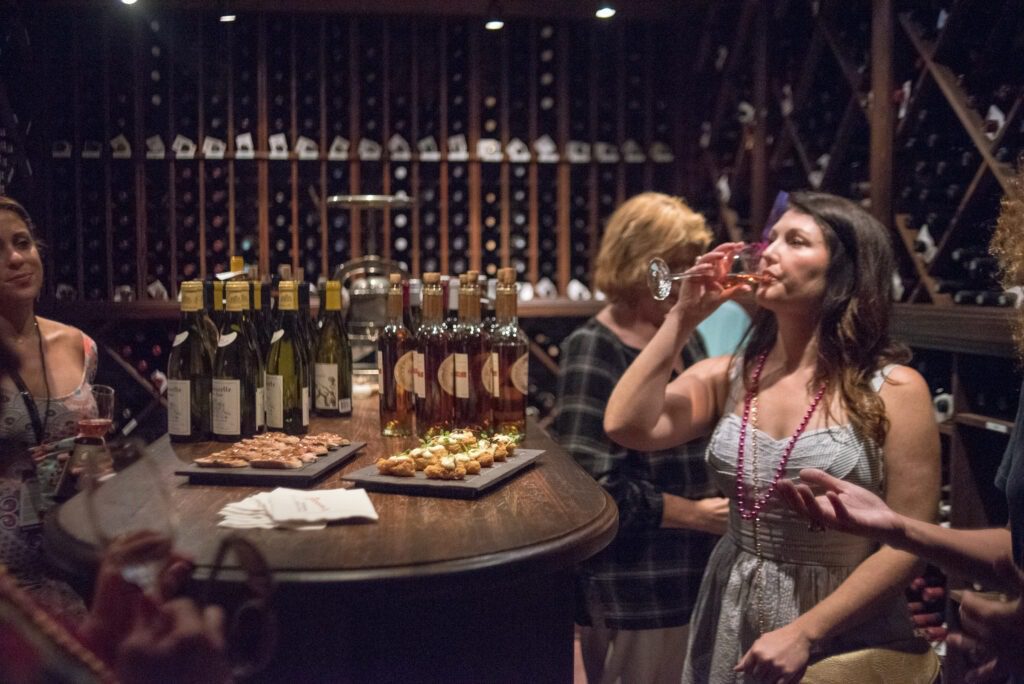
New Orleans Wine and Food Experience 2016. ©Brandt Images – All Rights Reserved.
Join Trixie Minx and her Burlesque Beauties for a one-of-a-kind NOWFE experience with a plated brunch prepared by the chefs at the Omni Royal Orleans, bottomless sparkling wine by Luc Belair, and a burlesque performance you are sure to remember.
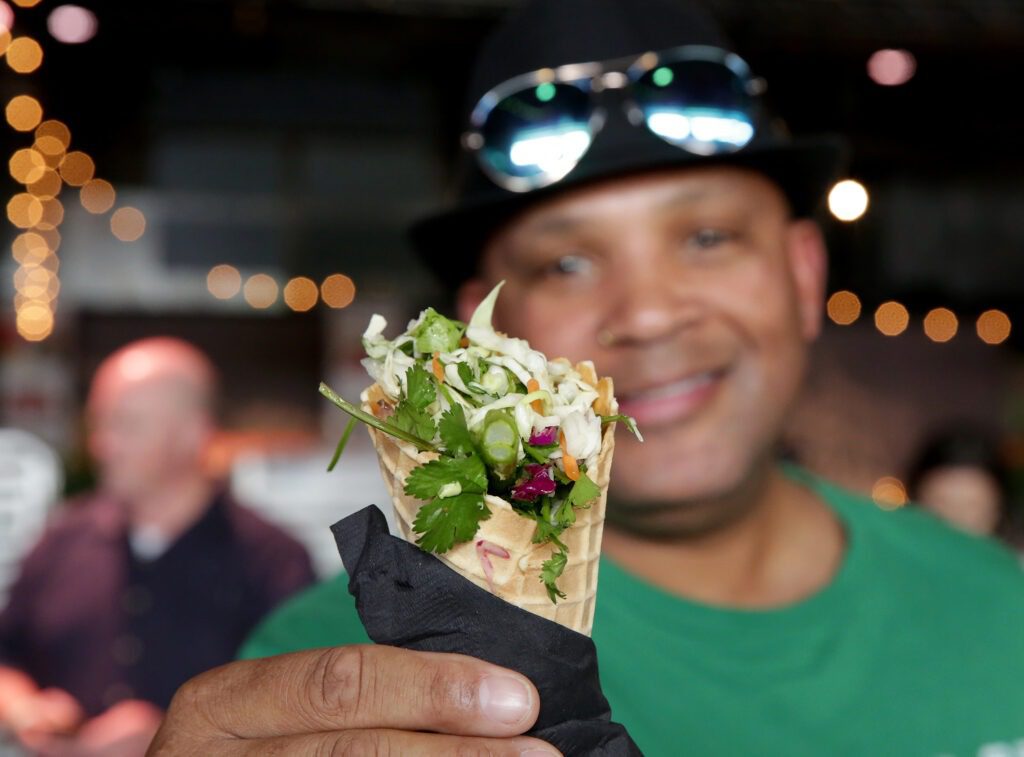
In addition to the special events, NOWFE presents its Labs and Experiences on Friday and Saturday. Five Labs will occur each day at the New Orleans Culinary & Hospitality Institute at various times, while five boutique Experiences will occur over the two days throughout the city. Ticket prices vary for the Labs and Experiences.
The three levels of event ticket packages available this year are:
The Tasting Package — $258 per person
This package gives a “taste” of the main events this season. It includes entrance to:
· Tournament of Rosés
· The Grand TastingThe Connoisseur Package — $793 per person
This package is for the wine and food enthusiast looking to be a part of the entire NOWFE experience. It includes 30 minutes of early entry and the following:
· Vinola
· Tournament of Rosés
· The Grand Tasting
· Choice of four (4) Labs
· 10% Discount on Additional Labs
· $20 Voucher to Use at NOWFE Merchandise Store
The VIP Package — $1000 per personUpgrade to the VIP Package! This ticket allows you to experience the event at the highest level. It includes 30 minutes of early entry, access to VIP areas, and the following:
· Vinola
· Tournament of Rosés (early entry)
· The Grand Tasting (VIP)
· Choice of five (5) Labs (with priority seating)
· 10% Discount on Additional Labs
· $20 Voucher to Use at NOWFE Merchandise Store
For more information or to purchase additional tickets, visit nowfe.com.
Post Views: 1,234 -
Dave Matthews Headlines Oceans Calling Festival Sept 30 – Oct 2 in Ocean City MD
Dave Matthews, Lumineers, Alanis Morissette headline Oceans Calling Festival Sept 30 – Oct 2 in Ocean City MD
Oceans Calling Festival Lineup
The highly anticipated Oceans Calling Festival launches this coming summer, with headliners Dave Matthews & Tim Reynolds performing on Friday; The Lumineers playing Saturday evening and Alanis Morissette closing out Sunday’s proceedings.
Featuring cooking shows from Chefs Andrew Zimmer, Robert Irvine, Amanda Freitag.
“We are thrilled to host Oceans Calling Festival in Ocean City, Maryland and celebrate all our incredible city has to offer,”
commented Mayor Rick Meehan.
“Thank you to C3 Presents and Maryland’s own O.A.R. for bringing an event of this magnitude to the Ocean City Boardwalk. We look forward to seeing everyone!”
Related:Post Malone announces Twelve Carat Tour 33-city including DC’s CapitalOne Arena with special guest Roddy Ricch.
A Wave Of Music
A three day festival in partnership with musicians O.A.R. featuring over 30 performances on 3 stages, all on the classic Ocean City Boardwalk.
Jolly Roger at the Pier
Explore the Ocean City tradition featuring amusement park rides, games and more, all located inside the festival grounds.
Oceans Calling Festival – A Culinary Celebration
Experience delicious east coast bites from local food vendors. Plus, learn tricks of the trade from world-renowned chef cooking demos that celebrate the region.
Explore Ocean City
Take in everything this iconic landmark 3-mile long boardwalk has to offer, lined with hotels, shops, bars, restaurants and more!
Oceans Calling will also bring a culinary experience hosted by world-renowned chefs Andrew Zimmern, Robert Irvine and Amanda Freitag with a stage dedicated to cooking demos that celebrate the eastern shore. In addition, The Jolly Roger at the Pier amusement park, located inside the festival grounds, will be fully operational during the festival.
For the lineup of bands, or to purchase one-day or three-day tickets visit www.oceanscallingfestival.com.
 Post Views: 227
Post Views: 227





